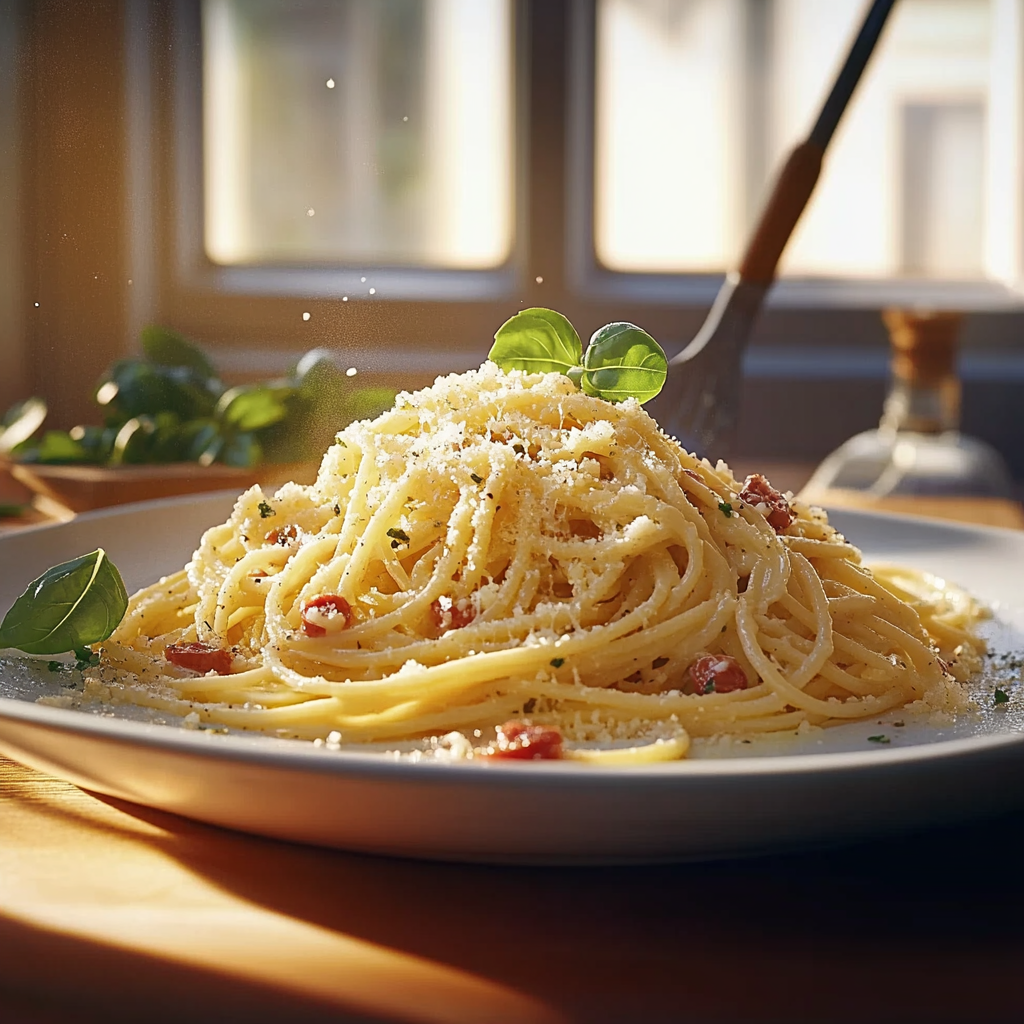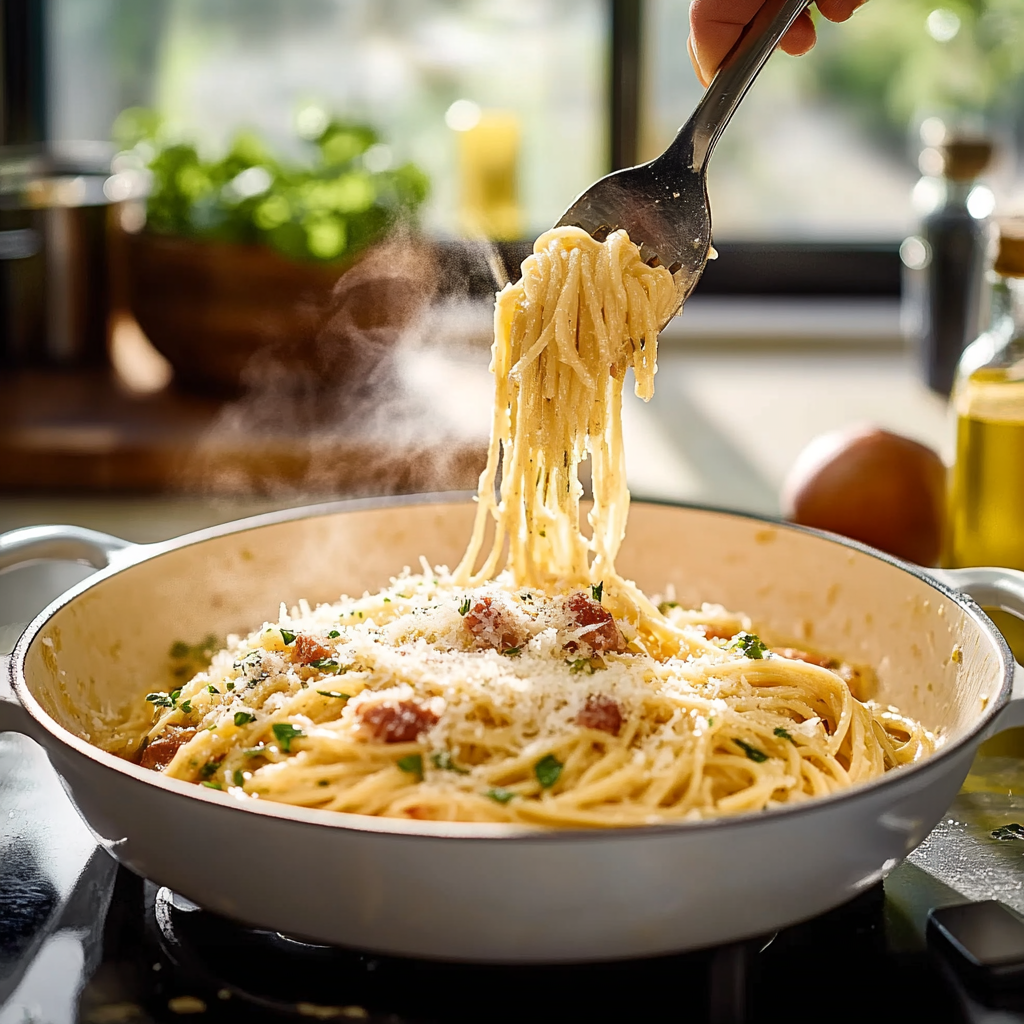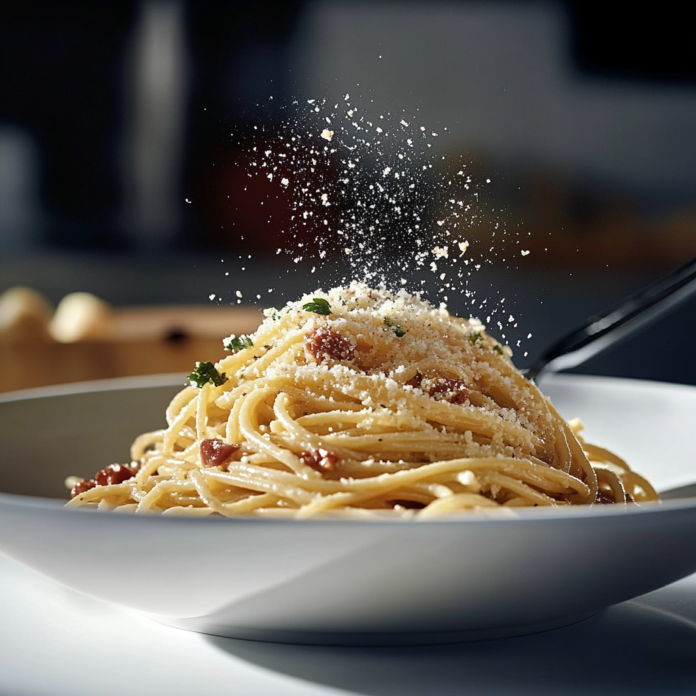Introduction and Quick Summary
If you’re looking for a classic dish that embodies the essence of Italian cuisine, look no further than Spaghetti Carbonara with Parmesan. This delectable pasta dish balances rich flavors and creamy textures in a way that is both comforting and indulgent. Originating from Rome, traditional carbonara features simple yet high-quality ingredients such as eggs, cheese, cured pork, and pepper. It’s not just about the components; it’s about how they work harmoniously to create a meal that warms your soul.
In this recipe, we will explore how to make an authentic Spaghetti Carbonara with Parmesan that will impress your family and friends. You’ll learn about each ingredient’s role in achieving that signature creaminess without using cream—it’s all about technique! Whether you’re a novice cook or a seasoned chef, this dish is approachable and rewarding. Enjoying a plate of homemade carbonara is like experiencing a piece of Italy right in your kitchen.
Prepare to dive into the world of pasta perfection! With straightforward instructions and tips on serving and storing this dish, you’ll have everything you need to create a memorable meal. Let’s get started!
Main Ingredients
Spaghetti
Spaghetti serves as the base of this delicious dish. Traditionally made from durum wheat semolina flour and water, it offers a firm texture that holds sauces well. For this recipe, you’ll need 400 grams of spaghetti. Cook it al dente according to package directions; this ensures it remains slightly firm while absorbing flavors from the sauce later on. When selecting spaghetti, opt for high-quality brands for the best results.
Eggs
Eggs are crucial for creating the creamy sauce in Spaghetti Carbonara with Parmesan. Use four large eggs; fresh organic eggs provide richer flavor and color to your dish. The yolks emulsify into the sauce when mixed with the hot pasta, giving it a velvety texture without needing cream. Remember not to overcook the eggs—this will prevent them from becoming scrambled.
Parmesan Cheese
Parmesan cheese adds depth of flavor and saltiness to your carbonara. You’ll need 100 grams of freshly grated Parmigiano-Reggiano for an authentic taste. Grating your cheese rather than using pre-packaged allows for better melting and integration into your sauce. The nutty undertones of good quality Parmesan elevate this dish significantly.
Guanciale (or Pancetta)
Guanciale is an essential ingredient contributing to the distinct flavor profile of carbonara. You’ll need 150 grams diced into small cubes or strips. This cured pork cheek is traditionally used but can be substituted with pancetta if unavailable. The fat renders out during cooking, infusing the pasta with its savory goodness while providing delightful crispy bits throughout.
Black Pepper
Freshly cracked black pepper is key for seasoning your Spaghetti Carbonara with Parmesan. Use around one teaspoon or adjust according to taste preferences. The pepper adds warmth and enhances other flavors without overpowering them; it’s best added at multiple stages during preparation for maximum impact.

How to Prepare Spaghetti Carbonara with Parmesan
Step 1: Cook the Pasta
Begin by bringing a large pot of salted water to a boil over high heat. Once boiling vigorously, add 400 grams of spaghetti carefully so as not to splash hot water on yourself! Stir occasionally for even cooking and prevent sticking together. Follow package instructions for cooking time but aim for al dente—about 8-10 minutes should suffice depending on thickness.
While waiting for the pasta to cook perfectly, set up your workspace by gathering all ingredients within reach: guanciale or pancetta diced small, eggs whisked together in a bowl along with grated parmesan cheese ready at hand.
Once cooked al dente, reserve about one cup of pasta water before draining it in a colander; this starchy water will help adjust sauce consistency later on if needed!
Step 2: Sauté Guanciale
In a large skillet over medium heat—preferably non-stick—add 150 grams diced guanciale (or pancetta) without any oil since these meats have enough fat content themselves! Cook gently until golden brown—around five minutes should do it! Stir frequently so they crisp evenly while releasing their flavorful oils into the pan.
When done cooking remove from heat but leave guanciale in its rendered fat until ready to combine everything together later on—it’ll add richness!
Step 3: Combine Eggs and Cheese
In another bowl whisk together four large eggs along with 100 grams grated parmesan cheese until well combined forming an almost smooth mixture resembling pancake batter consistency—this ensures even distribution throughout once mixed in!
It’s important NOT TO add salt here since both guanciale/pancetta already impart enough saltiness along with parmesan itself! Set aside until needed after mixing pasta in skillet next step!
Step 4: Mix Everything Together
Once you’ve drained spaghetti properly shake off excess water then transfer directly into skillet containing crispy guanciale still warm (but NOT hot). Quickly toss strands around ensuring they coat nicely within rendered fat giving flavor boost right away!
Now comes critical point; immediately pour egg/cheese mixture gently over hot pasta stirring vigorously! This action allows residual warmth from noodles cook eggs gently resulting soft creamy sauce rather than scrambled mess! If necessary use reserved starchy pasta water gradually adding little by little until desired thickness achieved!
Step 5: Adjust Seasoning & Serve
Taste test before serving adjusting seasoning if needed; perhaps additional cracked black pepper will enhance overall flavor profile even more! Once satisfied portion out servings onto plates garnishing extra parmesan shavings if desired alongside sprinkle fresh herbs like parsley or basil!
Your delightful bowlfuls await eager appetites ready indulge every luscious bite bursting rich flavors derived simply high quality ingredients used well throughout process!

Serving and Storing Tips
Serving Suggestions
When serving Spaghetti Carbonara with Parmesan ensure each plate showcases its deliciousness prominently! Utilize shallow bowls allowing ample space where strands lie gracefully atop crispy bits glistening invitingly under light showcasing appealing appearance!
For additional flair consider garnishing dishes lightly sprinkled fresh herbs such as chopped parsley or basil which provide bright contrast color-wise while enhancing aroma experience too making dinner feel special occasion every time served! Accompanying sides could include garlic bread or simple green salad dressed lightly vinaigrette complementing richness main course perfectly balancing meal overall enjoyable experience guests partake happily!
Encourage diners savor slowly appreciating nuances flavors bring forth; recommend pairing alongside crisp white wine like Pinot Grigio elevating dining atmosphere further enhancing enjoyment all around table making memories last beyond mere dining experience itself!
Storage Tips
Should you find leftovers after indulging thoroughly don’t fret; storing them properly ensures enjoying deliciousness again another day indeed possible! Allow cooled down portions room temperature first before transferring airtight container refrigerate quickly within couple hours preventing bacteria growth ensuring safety consumption later when craving strikes again!
Stored correctly leftover carbonara typically lasts three days max refrigerated although taste may degrade slightly due reheating process involved afterward keeping texture intact can be challenging sometimes! To reheat use microwave gently stirring intermittently adding splash reserved pasta water if necessary creating moisture back into dish aiding restoration creaminess making it nearly indistinguishable freshness level original batch prepared initially!
For longer storage options consider freezing portions sealed tightly against air exposure preventing freezer burn occurring which damages quality severely over time frame extending life up four months easily although best enjoyed sooner rather than later whenever possible reliving delightful moments shared around dining experience previously taken place together creating fond memories worth cherishing forever through culinary adventures embarked upon willingly united passion food brings forth joy discovered anew each time enjoyed timeless classic recipes shared cherished loved ones near dear hearts alike always bringing happiness fulfilling bellies searching warmth comfort found through home-cooked meals treasured lifetime long ahead awaiting delightfully serve eagerly awaiting tables everywhere across globe today tomorrow always beyond measure!
Mistakes to avoid
One common mistake when preparing Spaghetti Carbonara with Parmesan is using the wrong type of pasta. Authentic carbonara traditionally uses spaghetti, but many people substitute with other pasta types like penne or fusilli. While these may taste good, they won’t capture the essence of the dish. Spaghetti has a unique ability to hold onto the sauce and flavors, ensuring every bite is perfect. Stick to spaghetti for the best results.
Another frequent error is overcooking the pasta. Perfectly cooked spaghetti should be al dente, which means it retains a slight firmness when bitten. If you overcook the pasta, it will become mushy and fail to hold the sauce properly. To achieve this, follow the cooking instructions on the package but check the pasta one or two minutes before the suggested time. This way, you can achieve that ideal texture.
Using cream in your carbonara is a mistake that many home cooks make. Authentic Italian recipes do not include cream; instead, the creamy texture comes from emulsifying eggs and cheese. Adding cream dilutes the flavor and alters the dish’s traditional profile. Focus on using high-quality eggs and freshly grated Parmesan for that rich creaminess without needing additional ingredients.
Lastly, neglecting to properly mix the egg and cheese mixture into the pasta can lead to clumps rather than a smooth sauce. After draining your spaghetti, return it to low heat and add a small amount of reserved pasta water along with your egg mixture. Stir quickly to ensure an even coating over every strand of spaghetti while preventing scrambling of the eggs. This technique produces a silky sauce that beautifully coats each bite.
Tips and tricks
To master Spaghetti Carbonara with Parmesan, begin by selecting quality ingredients. The type of cheese you choose plays a crucial role in flavor development. Opt for Parmigiano-Reggiano rather than pre-grated varieties or cheaper substitutes. Freshly grated cheese melts better and enhances your dish’s overall taste significantly. Always grate your cheese just before use for maximum freshness.
Timing is essential in creating this classic dish. Prepare all components ahead of time so that you can act quickly once your pasta is cooked. Start by frying pancetta or guanciale until crispy while your spaghetti cooks simultaneously in boiling salted water. Having everything ready allows you to combine ingredients seamlessly without overcooking any part of your dish.
When mixing the egg and cheese mixture, be mindful of temperature control to avoid curdling. Use residual heat from freshly drained pasta instead of direct heat when combining with eggs and cheese. This gentle approach will gently cook the eggs without turning them into scrambled bits, yielding that desired creamy consistency.
Don’t forget about seasoning! Although carbonara contains salty ingredients like pancetta and Parmesan, adding a pinch of freshly cracked black pepper enhances flavor depth significantly. Seasoning at different stages can help build layers of flavor in your dish—don’t skimp on this important step!
Suggestions for Spaghetti Carbonara with Parmesan
Experimenting with variations can elevate your Spaghetti Carbonara with Parmesan experience without straying too far from tradition. One suggestion is incorporating seasonal vegetables such as peas or asparagus for added color and nutrition without overwhelming flavors. These additions should complement rather than dominate; therefore, use them sparingly so as not to mask those authentic tastes.
For those seeking more depth in flavor profiles, consider infusing olive oil with garlic before adding it to your pancetta or guanciale mixture during cooking. This subtle yet impactful change adds another layer of richness while remaining faithful to traditional methods.
If you’re looking for an alternative protein option, try smoked salmon instead of pancetta or guanciale for a unique twist that maintains creaminess through its fat content yet offers different nuances altogether—ideal for seafood lovers!
Lastly, think about serving suggestions as well! Pairing your carbonara with a simple arugula salad dressed lightly in lemon vinaigrette can provide balance against its rich flavors while enhancing freshness at every meal time.
FAQs
What is Spaghetti Carbonara with Parmesan?
Spaghetti Carbonara with Parmesan is an iconic Italian dish made primarily from spaghetti noodles combined with eggs, cheese (typically Parmigiano-Reggiano), cured pork (like guanciale or pancetta), and black pepper. The key lies in creating a creamy sauce without using cream itself; instead, it relies on beaten eggs emulsified together with melted cheese as they blend harmoniously through hot pasta after cooking.
How do I prevent my carbonara from becoming dry?
To keep your Spaghetti Carbonara with Parmesan moist and flavorful requires proper timing when mixing ingredients together! Ensure that you reserve some starchy cooking water before draining pasta; add this gradually while stirring egg mixtures into hot noodles – allowing them both time needed for blending well without drying out completely!
Can I substitute other cheeses besides Parmesan?
While authentic recipes specify Parmigiano-Reggiano due its distinct flavor profile & texture—experimenting within limits remains possible! Pecorino Romano provides sharper notes while Grana Padano yields milder alternatives if desired—but remember not all substitutes deliver same quality experience expected from classic versions!
Is it necessary to use pancetta or guanciale?
Though traditional recipes call specifically upon either cured meats such as guanciale/pancetta—they’re not absolutely required! Alternatives like bacon may suffice; however note their stronger smoky characteristics could alter original flavor intended—so adjust seasoning accordingly!
Can I make carbonara vegetarian-friendly?
Yes! While classic preparations involve meat-based components—vegetarian versions exist too! You might replace pancetta/guanciale entirely using sautéed mushrooms (for umami) alongside adding extra vegetables like spinach—or even roasted cauliflower providing hearty textures complementing creamy sauces effectively!
What are some common mistakes people make when making carbonara?
Common pitfalls include overcooking spaghetti leading mushiness; adding cream instead relying solely upon egg/cheese emulsion; failing mix mixtures properly which results clumpy sauces—and lastly mismanaging ingredient preparation timing causing chaos during assembly stages—leading dishes falling short their potential deliciousness!
Conclusion
In summary, mastering Spaghetti Carbonara with Parmesan requires attention to detail while avoiding common mistakes such as improper ingredient selection or preparation techniques that compromise authenticity! Stick closely to traditional methods by opting for high-quality ingredients—especially focusing on fresh cheeses—and perfect timing throughout various stages ensures success every time! Incorporating tips mentioned above allows flexibility within bounds defined by tradition permitting creative adaptations if desired! Remember: practice makes perfect so don’t be discouraged if first attempts don’t yield ideal results right away; gaining confidence comes naturally through experience enjoyed along journey exploring culinary delights found within iconic Italian cuisine staples like this beloved recipe!
